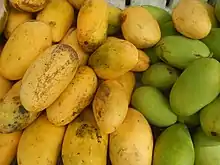Carabao (mango)
The Carabao mango, also known as the Philippine mango or Manila mango, is a variety of particularly sweet mango from the Philippines.[1] It is one of the most important varieties of mango cultivated in the Philippines. The variety is reputed internationally due to its sweetness and exotic taste.[2][3] The mango variety was listed as the sweetest in the world by the 1995 edition of the Guinness Book of World Records.[4] It is named after the carabao, a native Filipino breed of domesticated water buffalo.[5]
| Mangifera 'Carabao' | |
|---|---|
.jpg.webp)  | |
| Genus | Mangifera |
| Cultivar | 'Carabao' |
| Marketing names | Carabao mango, Philippine mango, Manila mango, Manila super mango, Kalabaw mango |
| Origin | Philippines |
There are 14 different strains of Carabao mango.[6] These strains include the Talaban and Fresco of Guimaras, MMSU Gold of the Ilocos Region and Lamao and Sweet Elena of Zambales. A comparative study conducted by Bureau of Agricultural Research of the Department of Agriculture in 2003 found that the Sweet Elena of Zambales is the sweetest Carabao mango strain.[7]
The Mexican Ataulfo and Manilita mango cultivars descended from the Philippine mango through the Manila galleon trade between 1600-1800. Both of these cultivars are sometimes referred to as "Manila mangoes" in trade.[8][9]
See also
- Mangga wani (Mangifera caesia) - Also known as Bayuno; another species of Mango native to the Philippines
References
- P.F., Baldiviano; F.M., Rodriguez; Breeding), Mendoza, E.M.T. (Philippines Univ. Los Banos, College, Laguna (Philippines). Inst. of Plant (1999). "Variation in polyphenol profile and content of different strains of mango (Mangifera indica L.) var. carabao and effects of environment". Philippine Journal of Crop Science (Philippines). Retrieved 2017-10-16.
- "Course:Go Mango, Hit the Jackpot!". E-Learning for Agriculture and Fisheries. Retrieved 1 August 2014.
- Delmo, Gemma (10 December 2010). "Carabao mango: Philippine's sweet pride". Far Eastern Agriculture. Retrieved 1 August 2014.
- Bayarong, Anthony (9 April 2011). "Farmers urged to produce sweet mangoes for export". Sun Star Pampanga. Retrieved 1 August 2014.
- Osborne, Christine (1989). Southeast Asian Food and Drink. Bookwright Press. p. 12. ISBN 9780531182345.
- Reyes, Rizal Raoul (20 May 2014). "PMSFC modernizing mango farming in PHL". Business Mirror. Archived from the original on 8 August 2014. Retrieved 1 August 2014.
- Fernandez, Rudy (2 December 2006). "Zambales Mango is RP's Sweetest". Philippine Star. Retrieved 1 August 2014.
- Rocha, Franklin H.; Infante, Francisco; Quilantán, Juan; Goldarazena, Arturo; Funderburk, Joe E. (March 2012). "'Ataulfo' Mango Flowers Contain a Diversity of Thrips (Thysanoptera)". Florida Entomologist. 95 (1): 171–178. doi:10.1653/024.095.0126.
- Adams, Lisa J. (19 June 2005). "Mexico tries to claim 'Manila mango' name as its own". The San Diego Union-Tribune. Archived from the original on 11 October 2018. Retrieved 11 October 2018.